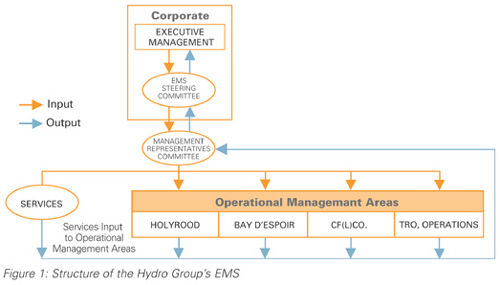|
The number and diversity of environmental challenges facing large companies require a structured
and consistent management approach. The Hydro Group has chosen the ISO 14001 Environmental Management
System (EMS) standard developed by the
International Organization for
Standardization to manage its environmental aspects. This decision has resulted in continual
improvement of environmental performance, while fulfilling our mandate to provide our customers with
cost-effective and reliable power.
The six designated management areas (Figure 1) within the Hydro Group are now managing their
environmental aspects through EMSs consistent with ISO 14001. Each EMS is certified and registered by
a third party, Quality Management
Institute (QMI). We are very proud of this accomplishment.
General accomplishments resulting from the Environmental Management Programs (EMP) in the Management
Areas in 2003 are noted below, however, details will be highlighted in the appropriate sections of
this report.
The Corporate Management Area consists of Executive Management and a Committee of Senior Managers. The
goal of this Management Area is to co-ordinate the development and maintenance of the overall EMS for
the Hydro Group. Although each EMS is managed independently, a common and consistent environmental policy
and principles sets the standard, and periodic reviews of activities and issues are conducted.
One of the most significant decisions related to the overall program was to amalgamate the individual
EMSs for the three regions of the Transmission and Rural Operations (TRO) Division into one. This is
expected to improve the efficiency of managing the EMS and allocation of resources to the appropriate
issues.

HOLYROOD
The Holyrood Thermal Generating Station is a 490 Megawatt (MW) thermal generating station located near
Holyrood, Conception Bay. Holyrood's EMS was initially registered in January 1999 and obtained
re-registration in 2002.
In 2003, Holyrood made progress on 11 Environmental Management Programs (EMP). These EMPs resulted in:
- a reduction in auxiliary power used at the plant;
- optimum unit efficiency;
- no reportable spills of controlled substance;
- removal of PCB waste and asbestos from the plant; and
- recycling of scrap metal.
BAY D'ESPOIR
The Bay d'Espoir Management Area consists of seven existing generating stations on the Island with an
installed capacity of 899 MW. In 2003, an eighth station constructed at Granite Canal (40 MW) was
commissioned and its environmental aspects incorporated into the EMS. The EMS was registered in 1999
and re-registered in 2002.
There were six EMPs worked on in 2003, which resulted in the following successes:
- improvement of generating equipment to reduce oil loss into the environment;
- no reportable spills; and
- enhancement of fuel storage facilities at remote locations throughout the system.
CHURCHILL FALLS (CF(L)CO.)
The Churchill Falls Hydroelectric Generating Station in Labrador has an installed capacity of 5,428 MW.
Associated with this development is approximately 1,200 km of high voltage transmission line, an airport,
and the Town of Churchill Falls. Environmental aspects of all these facilities are included in the EMS.
The environmental aspects of the moth-balled Twin Falls hydroelectric station are also managed
through CF(L)Co.'s EMS. The EMS was registered in 1999 and was re-registered in 2002.
The EMPs resulted in the following accomplishments:
- remediation of six stream crossing sites, and fabrication of three bridges to reduce the potential
impact on fish populations;
- reduction of oil loss through improved preventative and corrective maintenance;
- increased recycling of turbine oil;
- reduction of the number of reportable spills to one;
- improvement of environmental management at Twin Falls by installing remote detection equipment and
completing an environmental site assessment;
- expansion of the use of environmentally friendly turbine gate grease; and
- removal and recycling of 90 tonnes of scrap overhead ground wire from the high voltage transmission line.
TRANSMISSION AND RURAL OPERATIONS (TRO)
The TRO Division consists of three regions that manage 23 rural, isolated diesel generating plants
(30.2 MW), three gas turbine plants (125 MW), and approximately 8,300 km of transmission and distribution
lines, and associated switching stations. The three regions share a common EMS, which was registered
in 2003.
In 2003, eight environmental management programs resulted in:
- the study of alternative forms of applicators to reduce the use of herbicides for vegetation control;
- improved documentation of equipment that may contain PCB in order to develop plans for sampling and
replacement;
- improved tracking and management of treated transmission and distribution poles removed from service; and
- assessment of fording sites on access trails associated with transmission lines in Labrador to reduce the
potential impact on fish and fish habitat.
The Services Management Area includes services (eg. engineering design, system planning, environmental
services, procurement) and facilities (eg. Hydro Place, telecommunication sites) that support the
operation of the business. The Services EMS includes nine diverse environmental management programs. The
Services EMS was registered in 2000 and was recommended for re-registration in 2003.
The following accomplishments in 2003 are noteworthy:
- the halon replacement program was completed to the degree possible;
- 13 Phase I Environmental Site Assessments were completed on selected properties owned and operated by
the Hydro Group to identify any potential contamination requiring further investigation;
- energy efficiency from historical levels improving; and
- water management procedures were amended to accommodate the needs of the Granite Canal Fish Habitat
Compensation Facility.
|
